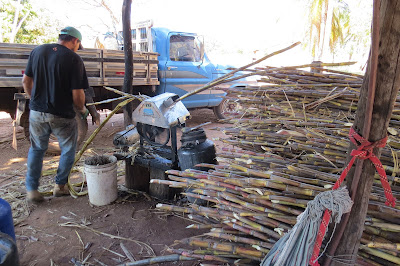The sweet smell of boiling sugar permeated the air when Lygia and I arrived at the towering bamboo that marked our first stop, a chacara or small farm.
This was where I would conduct my first wildlife-disease interview. I was nervous. What if my Portuguese was unintelligible? Would any of my questions be offensive or too personal? Would the farmer object to my audio recorder, the consent form, or even speaking with me?
The chacara's owner was too busy to talk with us, and we soon discovered why. He was cooking rapadura (pronounced hah-puh-doo-ruh) out back!
 |
| The first step to cooking rapadura is juicing the sugar cane. |
We were invited to try swirling glassfuls of fresh sugar-cane juice, a flavor at once sticky, sweet, green, and plant-like.
 |
| Two wide, metal kettles held the boiling brown liquid. |
The fresh juice is then boiled down to a thick, bubbling syrup over open flames. The process reminded me of my cousins' Vermont sugarbush, where they tap maple trees for sap and boil the clear fluid into maple syrup.
 |
| Lygia is a rapadurera in the making! |
 |
| When the right consistency is reached, the men poured the caramel-colored liquid into a wooden trough. |
 |
| It's hot, heavy, sticky work to pour molten sugar! |
 |
| Here, one of the confectioners spreads the rapadura to cool in a wooden trough for just the right amount of time. Then, roasted peanuts are mixed in. |
 |
| This beautiful wooden frame is put together like a set of Lincoln Logs. The peanut-sugar slurry is poured in. |
 |
| When the bricks of candy are cool, the wooden frame is removed. |
 |
| The bricks are stood on end to finish hardening. |
 |
| Voila, more sucrose than anyone should reasonably consume in a lifetime! |
We bought two bricks, and we've put them to creative use. Brown sugar is hard to come by here in Taboco, so we substituted grated
rapadura in my recipes for Tollhouse chocolate-chip cookies and Sloppy Joe's. The slight peanut flavor is a bonus.
And, amid the saccharine operation, I did manage to conduct my first interview with a young woman who lives on the
chacara. She was expecting her second child, and we even managed a simple conversation about her kids. The day was sweet from start to finish.
Mom's Daily Bird
 |
| Rufescent tiger heron. Socó-boi. Tigrisoma lineatum. This bird posed in the dirt road just before sunset as we finished a long day of fruit-surveys near Bonito. Alexine, the peccary researcher, told me, "We don't stop for birds! Only peccaries!" but this rule was relaxed for such a magestic fowl. |
Dad's Daily Bug
 |
| This nocturnal insect crawled around the patio at high-speed. A member of the family Gryllotalpidae, it's called a paquinha or mole-cricket. |











